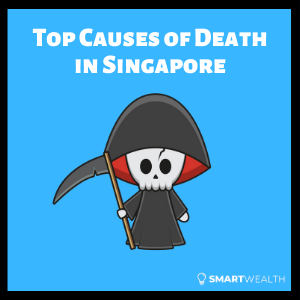Death is an inevitable part of life.
It is a natural process when a person’s life comes to an end. However, the loss of a loved one is painful, regardless of age or cause.
In Singapore, the death rate (age-standardised) has been declining and reached its lowest point in 2020 at 2.8 deaths per 1,000 residents.
What caused these deaths?
This article provides information about the top 10 causes of death in Singapore, as reflected in the latest statistics.
So, read on!
A Short Summary
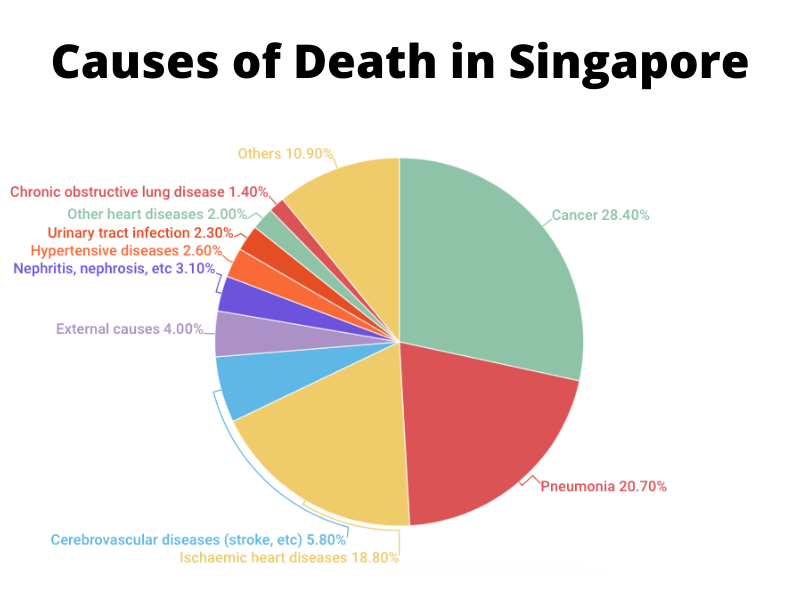
The number one cause of death in Singapore is cancer, followed by pneumonia and ischaemic heart diseases.
There’s much more to learn though. So, read on further.
SIDE NOTE When was the last time you conducted thorough financial planning or reviewed your finances? In this day and age in Singapore, doing so will absolutely improve the quality of life for you and your loved ones. Here are 5 reasons why financial planning is so important.
How Many Deaths Are There in a Year?
In 2020, Singapore had a population of 5,685,800, of which 4,044,200 were Singapore Residents (Citizens and Permanent Residents).
When we look at the death statistics in Singapore, the total resident deaths in Singapore have been on the incline over the years, from 14,715 in 2000 to 20,933 in 2020 (an increase of 42.3%).
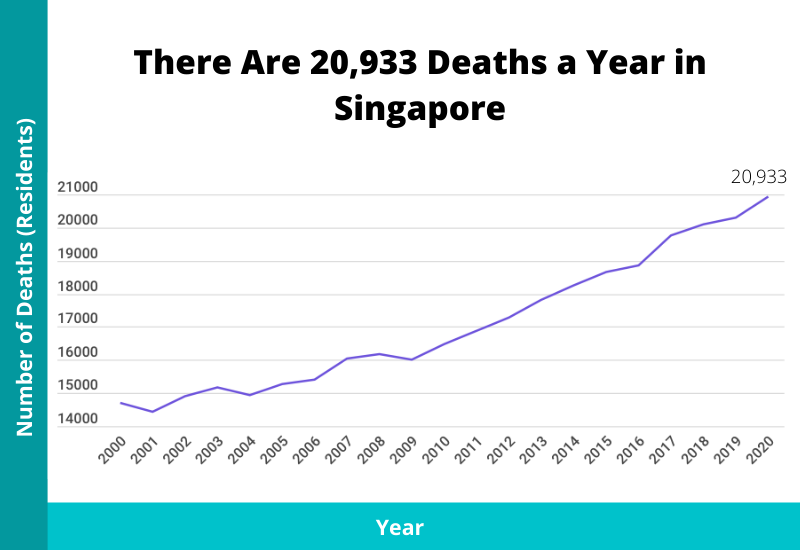
This roughly means that about 57 deaths are happening every day; 2-3 deaths every hour; one death every 25 minutes.
The crude death rate has been increasing as well. It was 4.5 deaths per thousand residents in 2000 and 5.2 in 2020.
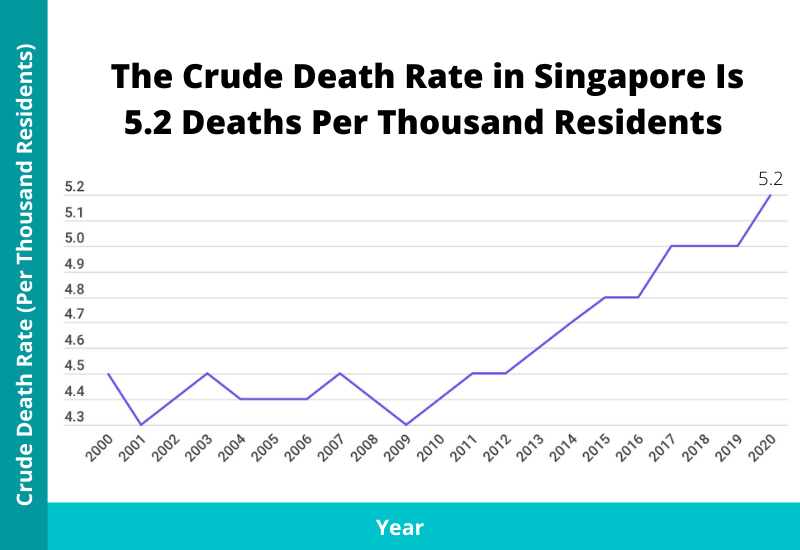
While the number of deaths and the crude death rate have increased, it doesn’t necessarily mean that the average Singaporean has a higher chance to die now.
Because of Singapore’s ageing population (a growing proportion of elderly people), more deaths are occurring. And thus, the numbers are “skewed”.
When we look at the specific-age death rate and the age-standardised death rate, we can see that they are decreasing.
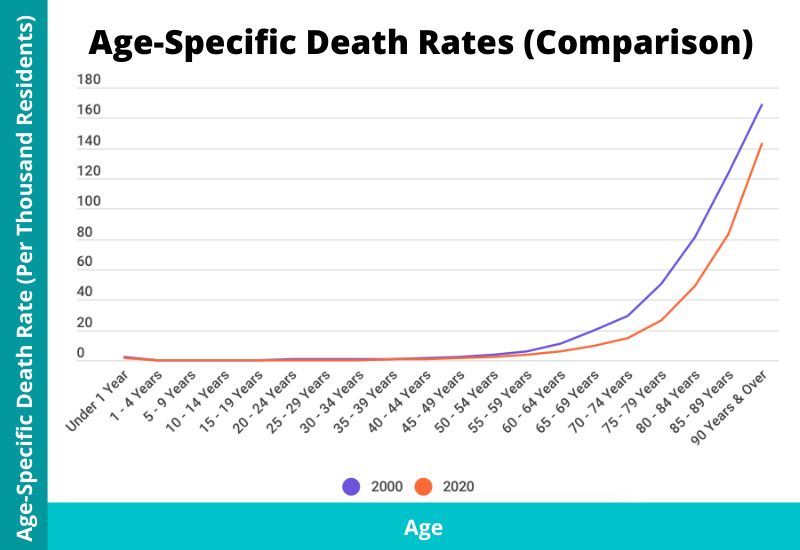
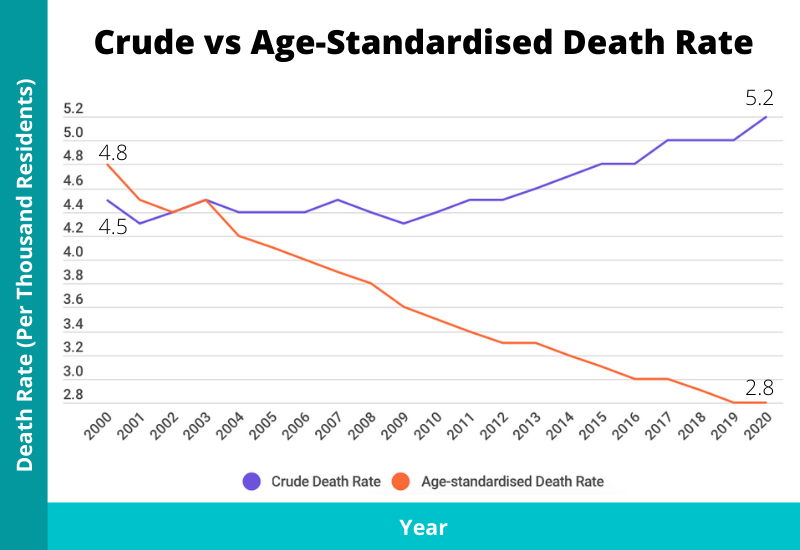
This is reflective of the improvements made in the health and mortality in Singapore. And is also why Singaporeans have a longer life expectancy now.
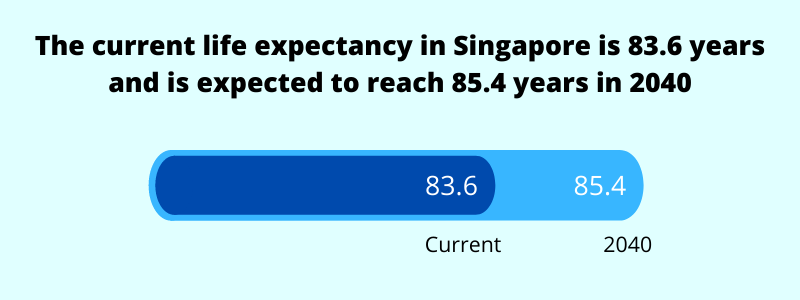
The Top 10 Causes of Death in Singapore
Here’s a list of the top 10 causes of death in Singapore:

| Causes | Percentage of Total Deaths |
| Cancer | 28.4% |
| Pneumonia | 20.7% |
| Ischaemic heart diseases | 18.8% |
| Cerebrovascular diseases (including stroke) | 5.8% |
| External causes of morbidity and mortality | 4.0% |
| Nephritis, nephrotic syndrome & nephrosis | 3.1% |
| Hypertensive diseases (including hypertensive heart disease) | 2.6% |
| Urinary tract infection | 2.3% |
| Other heart diseases | 2.0% |
| Chronic obstructive lung disease | 1.4% |
Cancer is still the leading cause of death in Singapore, accounting for 28.4% of all deaths. It’s also one of the most common critical illnesses.
It’s followed by Pneumonia and Ischaemic Heart Diseases accounting for 20.7% and 18.8%, respectively.
Just these 3 causes make up 67.9% of total deaths.
And when we sum up the top 10 causes, the total percentage equates to 89.1%. This meant that only 10.9% are from other causes.
Of the total deaths, illnesses and diseases made up the majority whereas external causes made up only 4%.
The Big 3
Since the top 3 causes make up the majority, it’s worth talking about them more.
DID YOU KNOW? According to a survey conducted by MoneySense, about 3 out of 10 Singapore residents aged 30 to 59 had not started planning for their future financial needs. This isn't surprising because personal finance can seem complicated and daunting. But really, there are only a few things that you should focus on. Learn how to significantly improve your personal finances with the 7-step "wedding cake" strategy today.
1) Cancer
Cancer is a disease that affects the body in various ways, depending on the type of cancer.
While it’s normal for cells to grow and get replaced through division. When this division becomes uncontrollable, cells may grow and develop abnormally.
The cancerous cells could form a tumour and potentially spread to other parts of the body through multiple ways.
The likelihood of developing cancer is 1 for every 4 to 5 Singaporeans by the age of 75.
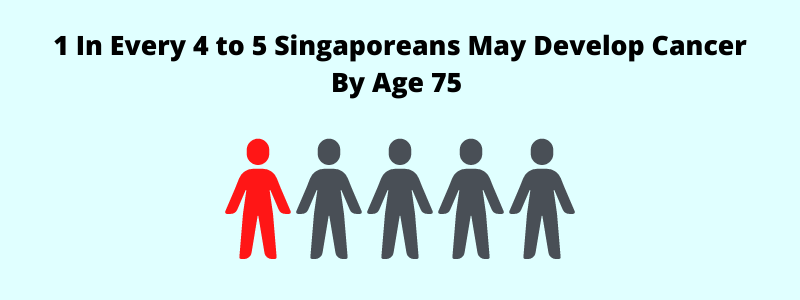
Why is the incidence rate so high?
There’s no one exact cause of cancer as there are many risk factors. Here are some of them:
- smoking
- excessive drinking
- sun & UV exposure
- unhealthy diet & lifestyle habits
- family history of cancer
- etc
So while we can’t change our genetic makeup, we can reduce the risk of cancer by employing healthy living habits.
In addition, with regular screening, early detection of cancer can be made. Doing so can increase the likelihood of survival.
2) Pneumonia
Pneumonia is an infection of the lungs that results from inflammation due to bacteria, viruses, fungi or other harmful substances.
It is characterised by symptoms such as fever, shortness of breath, cough and chest pain.
Individuals who have a weaker immune system are more susceptible to develop severe pneumonia. Here are a few groups:
- Young children
- Elderly aged 65 or older
- HID/AIDS patients
- People with chronic medical conditions
It is most commonly associated with infectious respiratory diseases such as influenza.
3) Ischaemic Heart Diseases
Ischaemic heart disease is also known as coronary artery disease.
The coronary arteries are responsible to supply blood to the heart. And the term “ischaemic” means “inadequate blood flow”.
So to put it simply, once these arteries are narrowed or “blocked” due to a buildup of plague, cholesterol etc, it can lead to a heart attack which is potentially fatal.
The risk factors include smoking, high blood pressure, obesity, high cholesterol and diabetes.
Depending on the situation, there are 2 main treatments.
The first is angioplasty with stenting. Basically a “balloon” is inflated to widen the narrowed artery. This process usually comes with a stent to lock in the position so that the artery remains open for continuous blood flow.
The second is a coronary artery bypass surgery. It creates a new route of blood flow that bypasses the “clogged” section of the artery from another section of the body.
Death Is Unpredictable
Death is a painful process, and we never know when it will strike. So we should make the best use of our remaining time for ourselves and our families and enjoy life to the fullest.
At the same time, we should also prepare for the worst by ensuring our loved ones will be looked after and reducing/eliminating any financial burden in the event of our death.
If you’re one of the few many people who are not covered for death or critical illnesses, you may be leaving yourself vulnerable to the financial hardship that comes with such a situation. Therefore, it is best to have sufficient life insurance coverage. Check how much you need with our calculator.
Life insurance and medical insurance will ensure that the money you have saved up for your long term financial goals such as retirement is not spent on hospital bills when you are sick.
Also, it will ensure income is replaced so that your family is adequately provided for in the event of a premature death.
